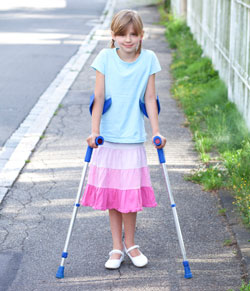Guest Blog: Breaking The Taboo And Ensuring A Better Life For People With Cerebral Palsy


Around the world nearly 15-20% of physically disabled children are affected by Cerebral Palsy. In India, the estimated incidence is around 3/1000 live births. Cerebral palsy is the most common motor disability in childhood. Because of lack of awareness and access to good quality healthcare services in semi-urban and rural areas, cerebral palsy has been a problem. Moreover, the stigma of cerebral is quite high owing to the lack of understanding among parents on ways to effectively manage it. Therefore, increasing education on cerebral palsy is a must.
Here is what to know.
What is cerebral palsy?
Cerebral palsy refers to a group of disorders that affect movement. It is a permanent, but not unchanging, physical disability caused by an injury to the developing brain, usually before birth. Cerebral palsy may only be mild and cause only a slight disruption to a person’s daily life. It can also be more severe, affecting the whole body, and may significantly impact how a person participates in daily activities.
Causes of cerebral palsy
cerebral palsy usually arises from a series of causal pathways i.e., a combination of events that can lead to an injury in a baby’s developing brain. In 13 out of 14 cases of cerebral palsy in India, brain injury leading to cerebral palsy occurs either in the uterus (while the mother is pregnant) or before 1 month of age. At present, the cause is not well understood for most of these babies. Stroke is the most common cause in babies who acquire cerebral palsy after one month of age. The stroke may occur spontaneously or arise from surgical or heart complications.
Some risk factors for cerebral palsy include:
- premature birth
- low birth weight (small for gestational age)
- blood clotting problems (thrombophilia)
- an inability of the placenta to provide the developing fetus with oxygen and nutrients
- RH or A-B-O blood type incompatibility between mother and baby
- infection of the mother with German measles or other viral diseases in early
- pregnancy
- bacterial infection of the mother, fetus, or baby that directly or indirectly
- attacks the infant’s central nervous system
- prolonged loss of oxygen during the pregnancy or birthing process, or severe
- jaundice shortly after birth.
It is important to understand that even if a mother or infant does have any of these risk factors, it doesn’t mean that this will result in cerebral palsy. It just means that the chance of having a child with cerebral palsy is increased.
“Cerebral palsy refers to a group of disorders that can affect a person’s ability to move and maintain balance and posture. They are usually caused by brain insults that occur before or during birth and manifest in infancy or early childhood.
The early clinical signs include delays in motor milestones of development. CP can be of various types including spastic (80%), dyskinetic, ataxic, or a combination of the above. Intellectual impairment, epilepsy, visual or hearing problems, or communication disorders may sometimes be associated with it.
But a lot of scientific progress has been made in the last few decades in understanding CP. The disability has been stratified on the basis of body structure, body function, and activity/participation of the individual.
Treatment involves a multidisciplinary team. The parents, the physiotherapist, the occupational therapist, the pediatrician, the neurologist all will work in tandem to make the child as normal as possible. Treatment of spasticity has been revolutionized by Botulinum toxin.
What we need to remember is that there’s hope. Parents should try to keep track of the development as much as possible “- Dr. Amit Halder, neurologist, Fortis Hospital Anandapur
Breaking stigma
Over the years there has been outstanding progress in understanding cerebral palsy from a medical standpoint. This has generated knowledge that is used in the prevention and management of the condition.
However, the biggest challenge is dealing with stigma. For most people with cerebral palsy, the individual effects of this condition extend far greater than any movement or postural issues. Having to deal with the social effects of disability can be quite damaging. Recognizing the different meanings of disability opens the door to the possibility of creating new meanings – ones that are empowering, rather than exclusionary.
On World Cerebral Palsy Day, it is important to break the stigma of it, increase awareness and education about the illness and ensure adequate resource allocation to improve prevention and management.
